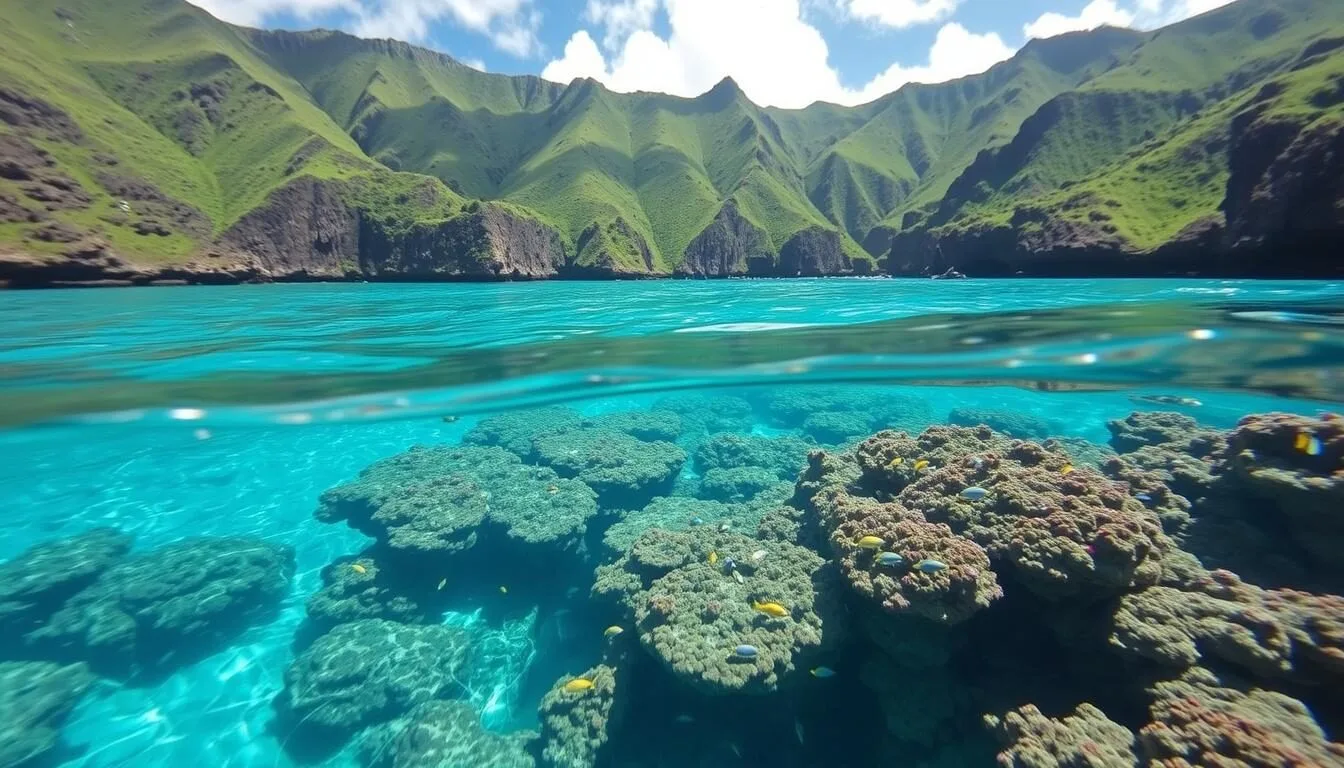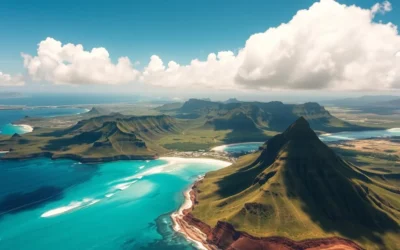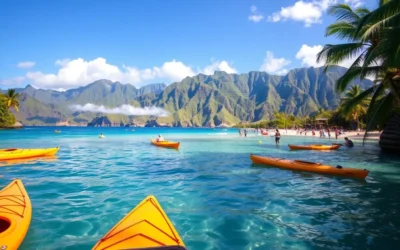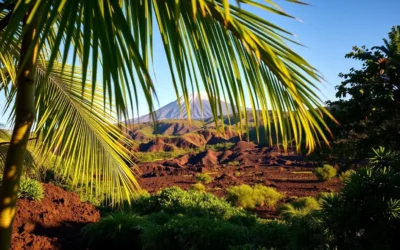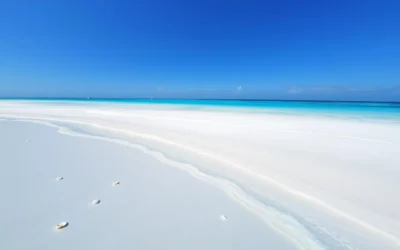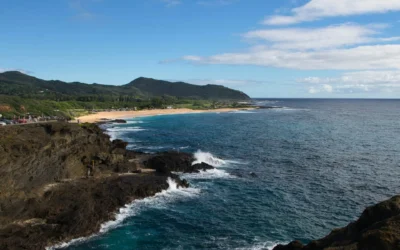✓ Accommodations ✓ Flights ✓ Rental Cars ✓ Tours & Activities
Imagine paddling or sailing into a serene, crystal-clear bay surrounded by towering sea cliffs and rich marine life. Welcome to Kealakekua Bay, a marine sanctuary on the Big Island’s western coast, renowned for its exceptional snorkeling opportunities.
This stunning bay is not only a haven for marine life but also a site of historical significance. As you explore Kealakekua Bay, you’ll experience the perfect blend of adventure and cultural discovery. Whether you’re snorkeling among tropical fish, kayaking to the Captain Cook Monument, or simply taking in the breathtaking views, Kealakekua Bay promises an unforgettable experience.
Our comprehensive guide will help you navigate this incredible destination, from practical tips on visiting the bay to insights into its rich history and marine life.
Discovering Kealakekua Bay: An Overview
Kealakekua Bay, a stunning marine sanctuary, offers an unforgettable experience on Hawaii’s Big Island. This picturesque bay is not only a treat for the eyes but also a haven for diverse marine life.
Location and Significance
Kealakekua Bay is situated on the western coast of the Big Island, approximately 12 miles south of Kailua-Kona in the South Kona district. The bay’s dimensions, spanning about 1.5 miles by 1 mile, make it the largest natural bay on the Big Island. Its significance extends beyond its natural beauty, representing an important cultural and historical site where Hawaiian history and Western exploration intersected. The name “Kealakekua” translates to “pathway of the gods” in Hawaiian, reflecting the spiritual importance this area held for native Hawaiians.
Marine Life Conservation District Status
As a Marine Life Conservation District since 1969, Kealakekua Bay enjoys special protections that have allowed its underwater ecosystem to flourish. The 315-acre Kealakekua Bay MLCD is the largest of all 11 Marine Life Conservation Districts in Hawaii. The conservation status means fishing and other consumptive uses are prohibited or severely limited, creating a safe haven for marine life. As a result, the bay is home to an abundance of coral reefs and a variety of marine life, including a pod of spinner dolphins that often rest in the bay.
- The bay is a paradise for snorkelers and kayakers, offering a glimpse into an vibrant underwater world.
- The conservation efforts have resulted in fish that show little fear of humans, making it an ideal spot for observing marine life.
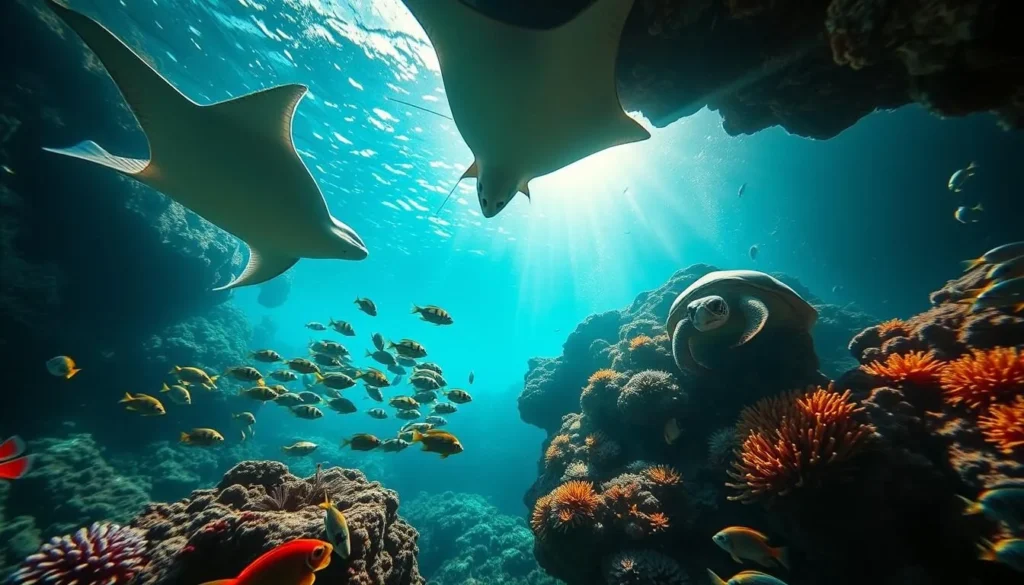
The Rich History of Kealakekua Bay
Kealakekua Bay, a place of profound historical significance, has been a cornerstone of Hawaiian culture for over a millennium. The bay’s rich history is multifaceted, encompassing ancient Hawaiian settlements, the arrival and fate of Captain James Cook, and the monument erected in his memory.
Ancient Hawaiian Settlement
The shores of Kealakekua Bay have been inhabited for over 1,000 years, serving as a significant cultural and settlement hub for ancient Hawaiians. As Hawaiian society advanced, the bay became a chiefly center with royal residences and religious temples, including the notable Hikiau Heiau.
Captain James Cook’s Arrival and Fate
In 1779, Captain James Cook sailed into Kealakekua Bay during the Makahiki season, initially enjoying peaceful exchanges with the Hawaiians. However, upon his return after the festival, tensions mounted, culminating in his death on February 14, 1779. This event marked a pivotal moment in Hawaiian history.
The Captain Cook Monument
A 27-foot white obelisk, the Captain Cook Monument, was erected in 1874 near the spot where Cook died. The land was deeded to the United Kingdom by Hawaiian Princess Likelike in 1877. Today, the monument stands as a historical marker and a popular destination for visitors.
| Event | Date | Significance |
|---|---|---|
| Captain James Cook’s Arrival | January 17, 1779 | First documented European to reach Hawaii |
| Captain James Cook’s Death | February 14, 1779 | Pivotal moment in Hawaiian history |
| Erection of Captain Cook Monument | 1874 | Historical marker and tourist destination |
Planning Your Visit to Kealakekua Bay
The key to enjoying Kealakekua Bay lies in planning your visit at the right time. With its calm and clear waters, this bay is a perfect spot for snorkeling and observing marine life.
Best Times to Visit
Visiting Kealakekua Bay in the early morning hours is ideal. The water is typically calmest before 10 AM, offering the best visibility for snorkeling. You’ll also encounter smaller crowds and have a better chance of spotting spinner dolphins.
Weather Considerations
The South Kona area enjoys warm and sunny weather year-round, with temperatures between 75-85°F (24-29°C). However, be prepared for afternoon trade winds that can create choppier waters, making it less ideal for water activities.
What to Bring
- Reef-safe sunscreen, a hat, and sunglasses for sun protection
- Snorkeling gear (if not renting), a towel, and a waterproof camera
- Sturdy closed-toe shoes and extra water if hiking to the Captain Cook Monument
Allow at least half a day to fully appreciate the bay, especially if you’re planning to snorkel or kayak.
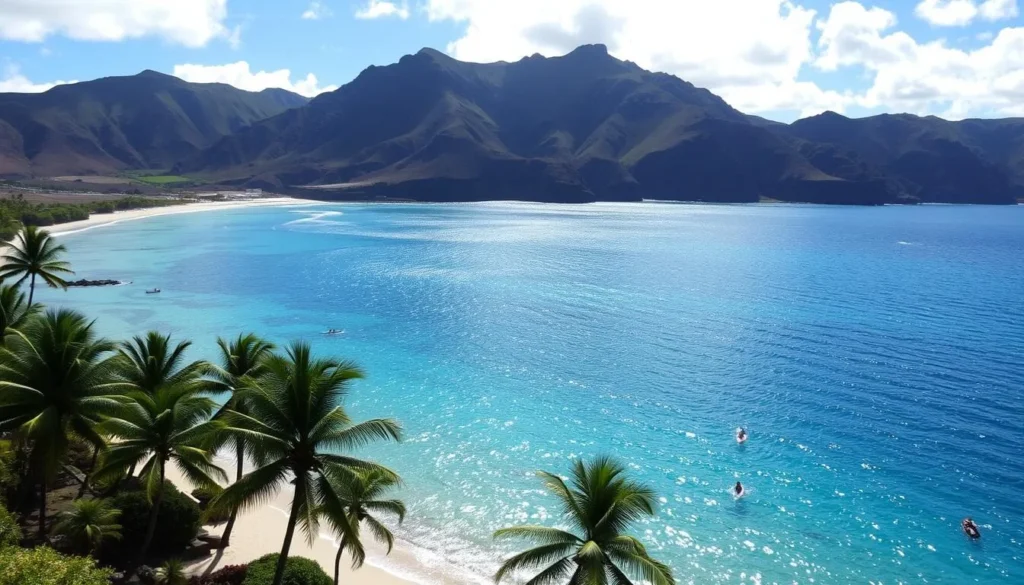
How to Get to Kealakekua Bay
The journey to Kealakekua Bay begins with a drive south on Highway 11 from Kailua-Kona. This scenic route will take you along the western coast of the Big Island, offering stunning views of the ocean and surrounding landscape.
Driving Directions
To reach Kealakekua Bay by car, take Highway 11 (also known as Mamalahoa Highway) south from Kona until you reach the Napo’opo’o Road turnoff near the 111 mile marker. The trailhead for the hike to the Captain Cook Monument is just a few hundred feet after this intersection.
- From Kailua-Kona, head south on Highway 11 for approximately 13 miles.
- Turn onto Napo’opo’o Road near the 111 mile marker.
- For the Captain Cook Monument trailhead, stop a few hundred feet after turning onto Napo’opo’o Road.
Parking Information
If you’re heading to the eastern shore of the bay, continue down Napo’opo’o Road for about 4.5 miles until you reach Napo’opo’o Beach Park. Be aware that parking is limited, with around 20 spaces available.
- Parking at Napo’opo’o Beach Park is limited, so arrive early, especially during peak season.
- There is no parking at the Captain Cook Monument; it’s accessible only by hiking, kayaking, or boat tour.
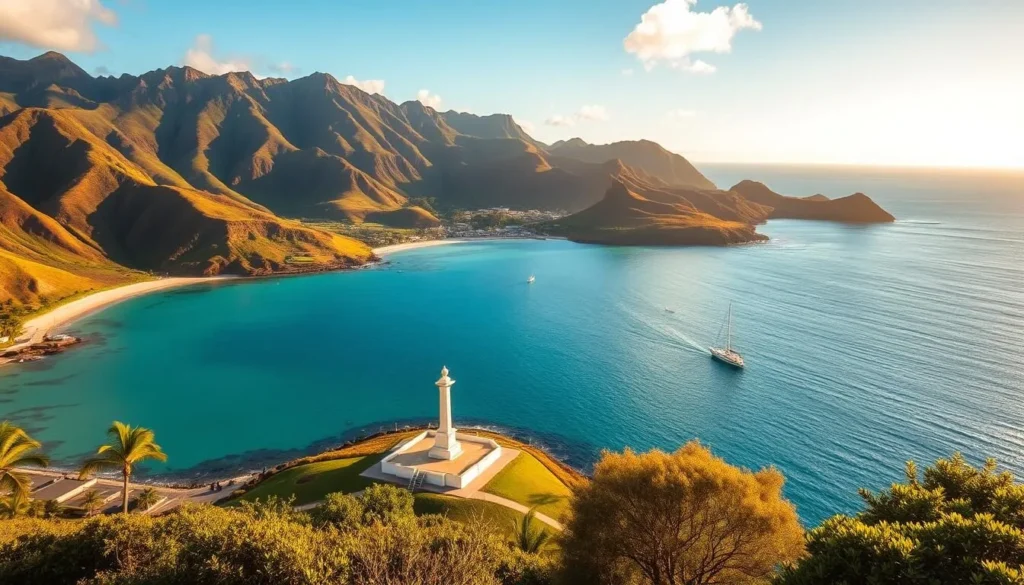
Snorkeling in Kealakekua Bay
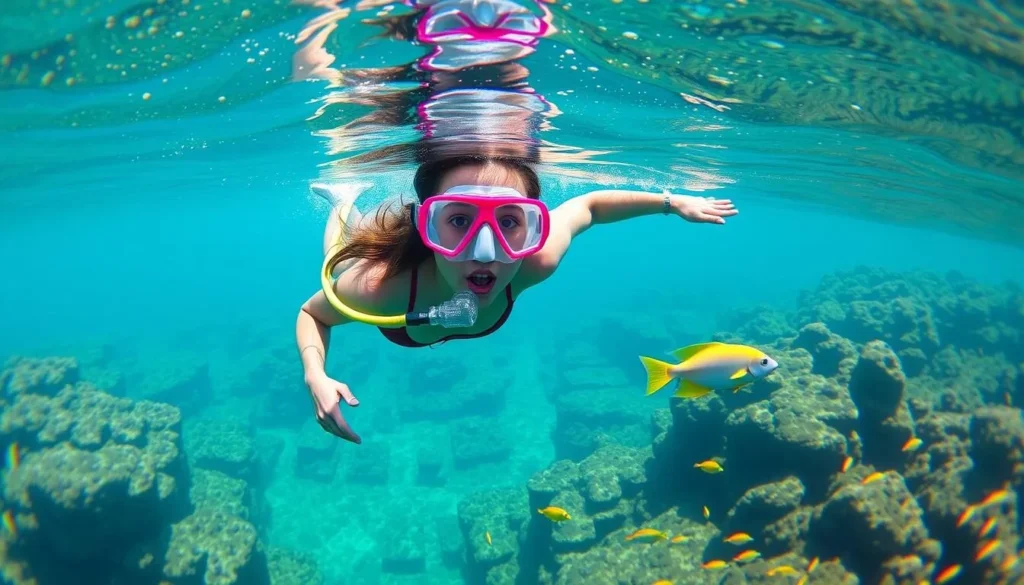
The crystal-clear waters of Kealakekua Bay make it a snorkeler’s paradise. As a protected marine area, the bay is home to an incredible array of marine life and coral reefs.
Best Snorkeling Areas
The premier snorkeling spot is located on the northern side of the bay near the Captain Cook Monument. The water is typically calm and clear, with visibility often exceeding 100 feet. For those on the eastern side of the bay, decent snorkeling can be found by heading south toward Manini Beach Point.
Marine Life You’ll Encounter
While snorkeling, you’ll encounter a diverse range of marine life, including colorful tropical fish like yellow tangs and butterfly fish, as well as Hawaiian green sea turtles and occasionally spinner dolphins. The coral reef is remarkably healthy, beginning in shallow water near the shore and extending down into deeper water.
Snorkeling Safety Tips
To ensure a safe and enjoyable experience, always snorkel with a buddy, be aware of changing water conditions, and avoid touching or standing on coral. Use reef-safe sunscreen and maintain a respectful distance from marine life, especially turtles and dolphins.
Kayaking Adventures in Kealakekua Bay
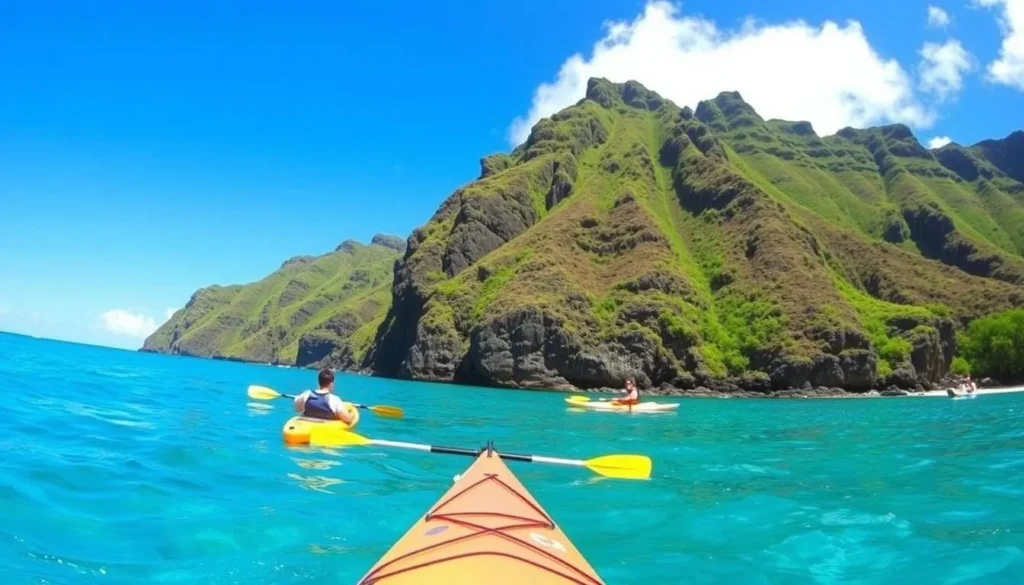
Paddling across Kealakekua Bay is an exhilarating experience, providing a unique perspective on the bay’s stunning landscapes and marine life. The bay’s calm waters make it an ideal location for kayaking, with the journey to the Captain Cook Monument being a highlight.
Permit Requirements
To kayak in Kealakekua Bay, you must obtain a permit, either by booking a guided tour with an authorized operator or by applying directly with the state. Conservation efforts are in place to protect the bay’s ecosystem, making permits mandatory for all kayaking activities.
Guided Kayak Tours
Guided kayak tours are an excellent way to explore Kealakekua Bay, offering equipment, safety instructions, and historical insights. As of 2023, only two companies, Adventures in Paradise and Kona Boys, Inc., are authorized to lead guided tours to the Captain Cook Monument.
Self-Guided Kayaking Tips
If you prefer self-guided kayaking, ensure your rental company has valid permits and be aware that landing at the Ka’awaloa Flats is not allowed. Bring plenty of water, sun protection, and secure your valuables. The best time to kayak is early morning when the waters are calmest.
Boat Tours to Kealakekua Bay
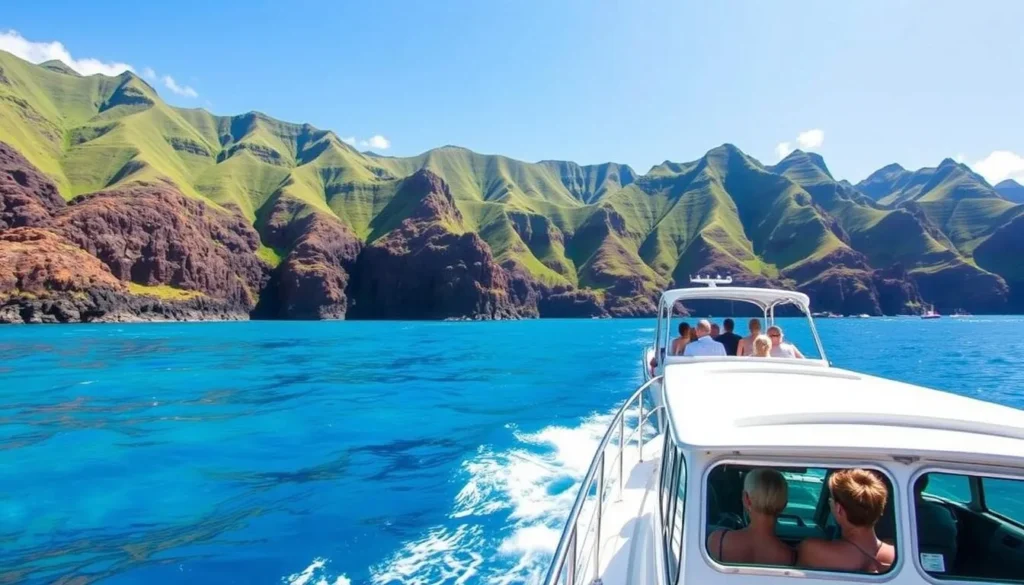
Taking a boat tour to Kealakekua Bay is the easiest and most convenient way to access the premier snorkeling areas without the physical exertion of hiking or kayaking. Boat tours depart from several locations, including Kailua-Kona pier, Keauhou Bay, and Honokōhau harbor, offering different experiences ranging from large catamarans to intimate private charters.
Types of Tours Available
A variety of boat tours are available, ranging from large tour companies with boats that hold a hundred or more guests and offer on-board dining, entertainment, and gear, to small private charters that take up to six passengers. Tour operators like Sea Paradise and Fair-Wind, which depart from Keauhou Bay, follow the Sustainable Tourism Association of Hawaiʻi guidelines.
What to Expect on a Boat Tour
Most snorkeling boat tours provide all necessary equipment, including masks, snorkels, fins, and flotation devices, as well as instruction for beginners and guidance on the best spots to see marine life. In addition to snorkeling time, boat tours generally include historical and cultural narration about Kealakekua Bay, light refreshments or meals, and sometimes additional activities like underwater viewing windows or slides into the water.
Hiking to the Captain Cook Monument
For those seeking adventure, hiking to the Captain Cook Monument is a challenging yet rewarding experience. The trail offers a unique opportunity to explore Kealakekua Bay on foot and enjoy the surrounding landscape.
Trail Description and Difficulty
The hike to the Captain Cook Monument follows an old cart road created by missionaries in the 1820s, spanning approximately 1.9 miles one way with a significant elevation change of about 1,300 feet. This challenging trail is best suited for experienced hikers in good physical condition, as the descent is steep and the return journey uphill can be particularly strenuous, especially after spending energy snorkeling.
Hiking Safety and Preparation
To ensure a safe and enjoyable hike, it’s essential to be well-prepared. Here are some key considerations:
- Bring at least 2 liters of water per person to stay hydrated throughout the hike.
- Wear sturdy, closed-toe shoes with good traction to handle the steep and rocky terrain.
- Protect yourself from the sun with a hat, sunscreen, and sunglasses.
- Pack light snacks to maintain your energy levels during the hike.
| Hike Details | Requirements |
|---|---|
| Distance | 1.9 miles one way |
| Elevation Change | 1,300 feet |
| Water Requirement | At least 2 liters per person |
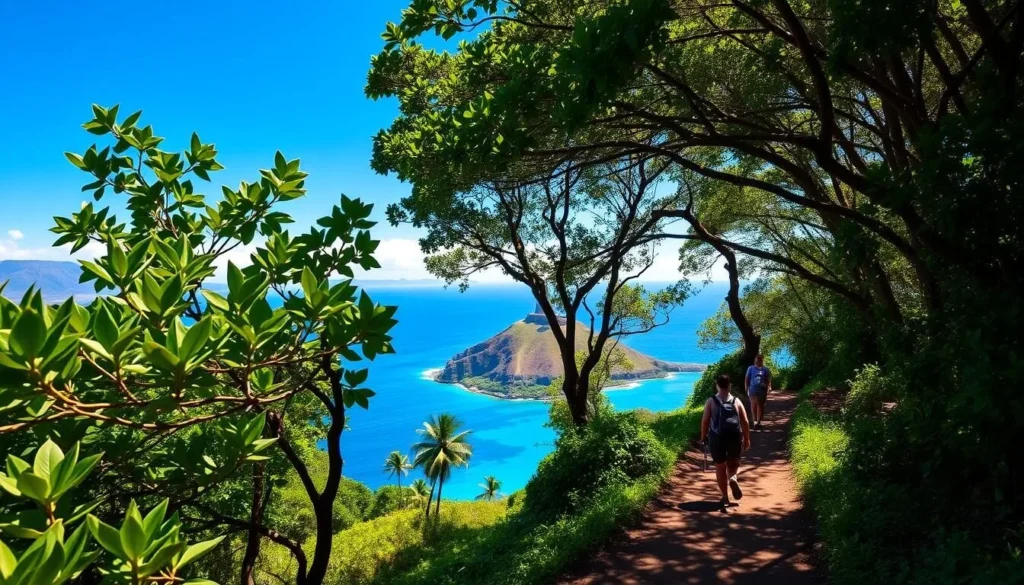
Kealakekua Bay State Historical Park Facilities
The Kealakekua Bay State Historical Park is a significant cultural and historical site on the Big Island of Hawaii. As you explore the park, you’ll find various amenities and services that enhance your visit.
Amenities and Services
The most accessible part of the Kealakekua Bay State Historical Park is at Napo’opo’o Beach Park, where you can find limited parking, restrooms, outdoor showers, a picnic pavilion, and a water fountain. This area is open daily from 7 AM to 9 PM, although there is no lifeguard on duty. Visitors can also view the Hikiau Heiau, an ancient Hawaiian temple dedicated to the god Lono.
Rules and Regulations
To preserve the park’s natural and cultural resources, certain rules must be followed. These include not removing rocks, coral, or archaeological artifacts, and not fishing or collecting marine life within the Marine Life Conservation District. Additionally, all waste must be disposed of properly, and kayakers must obtain the necessary permits. Maintaining a safe distance from marine mammals, such as spinner dolphins, is also crucial.
| Facility | Availability |
|---|---|
| Parking | Limited |
| Restrooms | Available |
| Outdoor Showers | Available |
| Picnic Pavilion | Available |
| Water Fountain | Available |

Conclusion: Making the Most of Your Kealakekua Bay Experience
With its rich history, stunning natural beauty, and incredible snorkeling opportunities, Kealakekua Bay is a true Hawaiian gem. To make the most of your experience, consider visiting early in the morning to avoid crowds and spot spinner dolphins before they rest.
Whether you choose a boat tour or kayak adventure, each offers a unique perspective. Remember to respect the bay’s natural and cultural resources, and enjoy the world-class snorkeling and potential dolphin sightings. By doing so, you’ll have an unforgettable experience in this beautiful bay.
The above is subject to change.
Check back often to TRAVEL.COM for the latest travel tips and deals.
